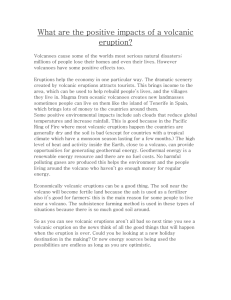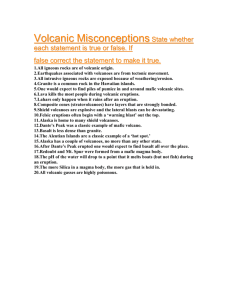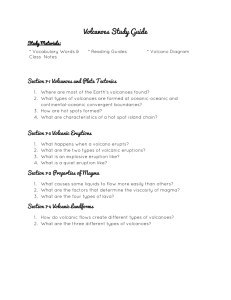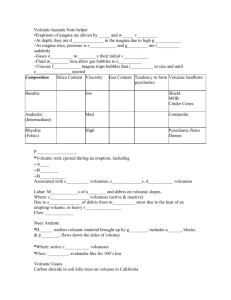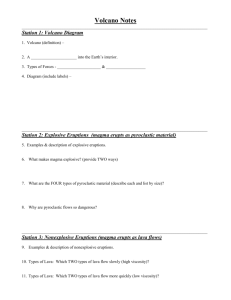GY 111: Physical Geology UNIVERSITY OF SOUTH ALABAMA
advertisement
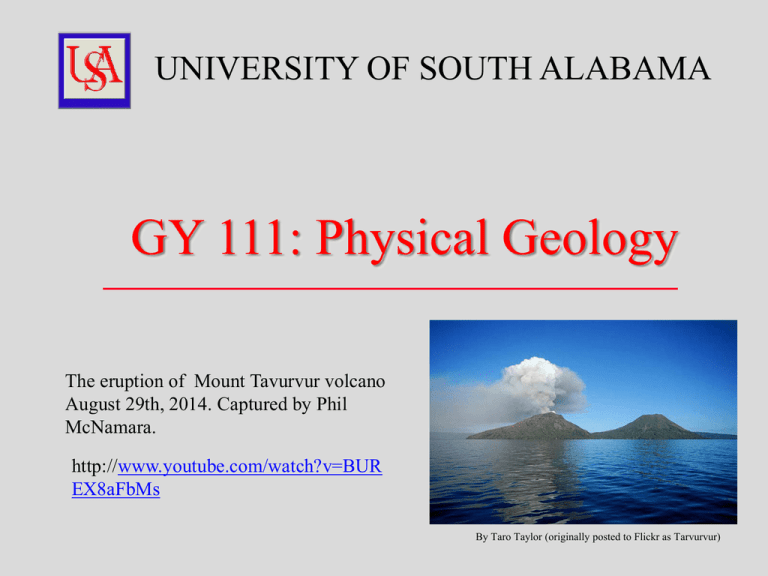
UNIVERSITY OF SOUTH ALABAMA GY 111: Physical Geology The eruption of Mount Tavurvur volcano August 29th, 2014. Captured by Phil McNamara. http://www.youtube.com/watch?v=BUR EX8aFbMs By Taro Taylor (originally posted to Flickr as Tarvurvur) UNIVERSITY OF SOUTH ALABAMA GY 111: Physical Geology Lecture 7: Volcanic Landforms, Features and Case Studies Instructor: Dr. Douglas W. Haywick Last Time 1. Review of where volcanoes occur 2. Properties of magma/lava (viscosity) 3. Basic types of volcanoes Where Volcanoes Occur 2) Convergent P. B. 3) Hot Spots. 1) Divergent P. B. Divergent Plate Boundaries Rapid rise of magma to surface because of multiple fractures and faults (low resistance) Magma (molten rock inside the Earth) rises upwards along fractures and fault as plutons (inverted tear dropshaped blebs 100’s to 1000’s of m in diameter). Why?.... Buoyancy. Hot magma is less dense than cool country rock Convergent Plate Boundaries Subduction 35 km Plutons rise at convergent plate boundaries too…. … but they have to burn their way up. This is not an easy trip to the surface. Hot Spots Properties of Magma/Lava 1. 2. 3. Magma derived from just below the lithosphere (e.g., 100 km down) is hot (2000 °C) and very fluid (low viscosity) Lava erupted at divergent plate boundaries and oceanic hotspots has made it to the surface of the Earth quickly and is still hot (up to 1800 °C) and fluid (low viscosity). Lava erupted at convergent plate boundaries and continental hotspots has made it to the surface of the Earth very slowly. It is cooler (as low as 800 °C) and very contaminated by country rock and water (high viscosity) Types of Volcanoes http://volcanoes.usgs.gov/Imgs/Jpg/Photoglossary/30424305-084_large.JPG Cinder cone in Hawaii http://www.discoverourearth.org/student/volcanoes/images/shield_volcanoes_big.jpg Shield Volcanoes (Mauna Loa, Mauna Kea, HI) Composite Volcanoes in Japan (Mt. Fuji) Pyroclastic flows Shield volcanoes produce annoying eruptions (but generally not disastrous) Today’s Agenda 1. Volcanic Landforms 2. Volcanic eruptions (case studies) 3. Measurements of activity Web notes 7 Cross-section of an Active Composite Volcano Chalk board time Landforms of Extinct Volcanoes http://www.uwgb.edu/dutchs/GRAPHIC0/ROCKMIN/Ig-Rocks/CALDERA.GIF Calderas: Can form via collapse (boring) or explosion (exciting). When filled with water they are called crater lakes. Volcanic Islands (Island Arcs) Island Arcs: chains of composite volcanic islands that pop up on the overriding plate along an oceanic-oceanic plate boundary Volcanic Islands (Island Arcs) Island Arcs: chains of composite volcanic islands that pop up on the overriding plate along an oceanic-oceanic plate boundary Volcanic Eruptions (Rocks) Shield Volcanoes, fissure eruptions, oceanic hot spots: all produce low viscosity lava flows that when cooled, form rocks like basalt Volcanic Eruptions (Rocks) Shield Volcanoes, fissure eruptions, oceanic hot spots: The lava flows come in two main “flavors” Pahoehoe (AKA ropey) Aa (AKA jagged) Volcanic Eruptions (Rocks) Composite Volcanoes and continental hot spots: produce high viscosity lava flows that might flow and form rocks like rhyolite… Volcanic Eruptions (Rocks) Composite Volcanoes and continental hot spots: produce high viscosity lava flows that might flow and form rocks like rhyolite… or blow-up and form pyroclastic deposits like volcanic ash Volcanic Eruptions (Rocks) Composite Volcanoes and continental hot spots: are dangerous Mt. Pinatubo David H. Harlow/U.S.Geological Survey Volcanic Eruptions (Case Studies) 1) Kilauea, Hawaii Volcanic Eruptions (Case Studies) 2) Mt Nyiragongo, Africa http://www.gomafilmproject.org/images/nyiragongopretty.gif Volcanic Eruptions (Case Studies) 2) Lake Nyos, Africa Volcanic Eruptions (Case Studies) 2) Lake Nyos, Africa Volcanic Eruptions (Case Studies) 2) Lake Nyos, Africa Volcanic Eruptions (Case Studies) 2) Lake Nyos, Africa Volcanic Eruptions (Case Studies) 3) Mt Pelée, Martinique Volcanic Eruptions (Case Studies) 3) Mt Pelée, Martinique Nueé Ardent Volcanic Eruptions (Case Studies) 3) Mt Pelée, Martinique Volcanic Eruptions (Case Studies) 4) Mt Unzen Japan Volcanic Eruptions (Case Studies) 4) Mt Unzen Japan Lahar Volcanic Eruptions (Case Studies) 4) Mt Krakatoa today Lahar Volcanic Eruptions (Case Studies) 4) Mt Krakatoa http://www.drgeorgepc.com/Tsu1883Krakatau15daysBefore.jpg 1883 Volcanic Eruptions (Case Studies) 4) Mt Krakatoa 1883 (7 weeks later) Volcanic Eruptions (Case Studies) 4) Mt Krakatoa Tsunami 15 meter (45 feet!) Travel Times (minutes) Tsunami height (metres) http://www.drgeorgepc.com/Tsunami1883Krakatau.html Volcanic Eruptions (Case Studies) 4) Mt Krakatoa Anak Krakatoa Today (kind of) Volcanic Activity Three states of activity are recognized: Volcanic Activity Three states of activity are recognized: 1) Active - the volcano is either erupting now, or there is a historical record of it erupting in the past (e.g., Mt. Vesuvius in Italy) Volcanic Activity Three states of activity are recognized: 2) Dormant - no record of recent activity (i.e., no historical observations), but the volcano looks “fresh” and may show some signs of thermal activity (e.g., Mt. Shasta, California) Volcanic Activity Three states of activity are recognized: 3) Extinct: it may be a volcano, but it is badly eroded, tree encrusted and shows no signs of thermal activity (e.g., Diamondhead, Oahu, Hawaii). http://www.sternwarte.uni-erlangen.de/~ai32/hawaii/diamondhead.jpg Volcanic Activity (recap) Three states of activity are recognized: 1) Active - the volcano is either erupting now, or there is a historical record of it erupting in the past 2) Dormant - no record of recent activity (i.e., no historical observations), but the volcano looks “fresh” and may show some signs of thermal activity 3) Extinct - it may be a volcano, but it is badly eroded, tree encrusted and shows no signs of thermal activity Today’s Homework 1. Come up with a plan for world peace 2. Minerals exam in Haywick’s labs this week Next Time 1. Quiz 4: definitions 2. Bowen’s Reaction series and the crystallization of magma GY 111: Physical Geology Lecture 7: Volcanic Landforms, Features and Case Studies Instructor: Dr. Doug Haywick dhaywick@southalabama.edu This is a free open access lecture, but not for commercial purposes. For personal use only.



